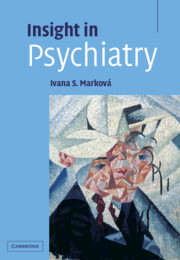Book contents
- Frontmatter
- Contents
- Dedication
- Preface
- Part I Historical and Clinical
- 1 Historical overview
- 2 The psychological perspective: Gestalt, cognitive and psychoanalytic
- 3 Insight in clinical psychiatry: empirical studies
- 4 Insight in organic brain syndromes: insight into neurological states
- 5 Insight in organic brain syndromes: insight into dementia
- Part II Conceptual
- References
- Index
2 - The psychological perspective: Gestalt, cognitive and psychoanalytic
from Part I - Historical and Clinical
Published online by Cambridge University Press: 22 October 2009
- Frontmatter
- Contents
- Dedication
- Preface
- Part I Historical and Clinical
- 1 Historical overview
- 2 The psychological perspective: Gestalt, cognitive and psychoanalytic
- 3 Insight in clinical psychiatry: empirical studies
- 4 Insight in organic brain syndromes: insight into neurological states
- 5 Insight in organic brain syndromes: insight into dementia
- Part II Conceptual
- References
- Index
Summary
A significant influence on both the conceptualisation of insight in psychiatry as well as on its empirical assessment, particularly within the neurosciences (e.g. in specific neurological deficits, neuropsychological impairments, dementias, etc.), has come from psychology. Such influence has, in the main, arisen predominantly from two psychological schools of thought, namely, Gestalt psychology (and Gestalt-influenced cognitive psychology) and the psychoanalytic psychologies. Whilst it is not the place here to explore the history of psychology as a discipline, it may be useful to very briefly contextualise the origin of the above schools of thinking. Neuropsychological approaches to the conceptualisations of awareness will be dealt with in Chapters 4 and 5.
The previous chapter highlighted the contribution made to the conceptualisation of insight as a clinical phenomenon by, amongst other things, the emergence of or focus on various psychological concepts during the eighteenth and nineteenth centuries. Amongst these, the notions of Verstehen, introspection, self-reflection, apperception, etc. were particularly important and related in different ways to attempts at describing and understanding the subjectivity of inner experiences. Towards the end of the nineteenth century, psychology was concerned with the scientific study of the contents or ‘facts’ of consciousness. These facts of consciousness ranged from the most basic or ‘atomic’ units of analysis, such as sensation or attention to more complex units such as perceptions, apperceptions or memory, which were understood as being formed from the combination of the atomic units through the laws of associationism.
- Type
- Chapter
- Information
- Insight in Psychiatry , pp. 34 - 65Publisher: Cambridge University PressPrint publication year: 2005

